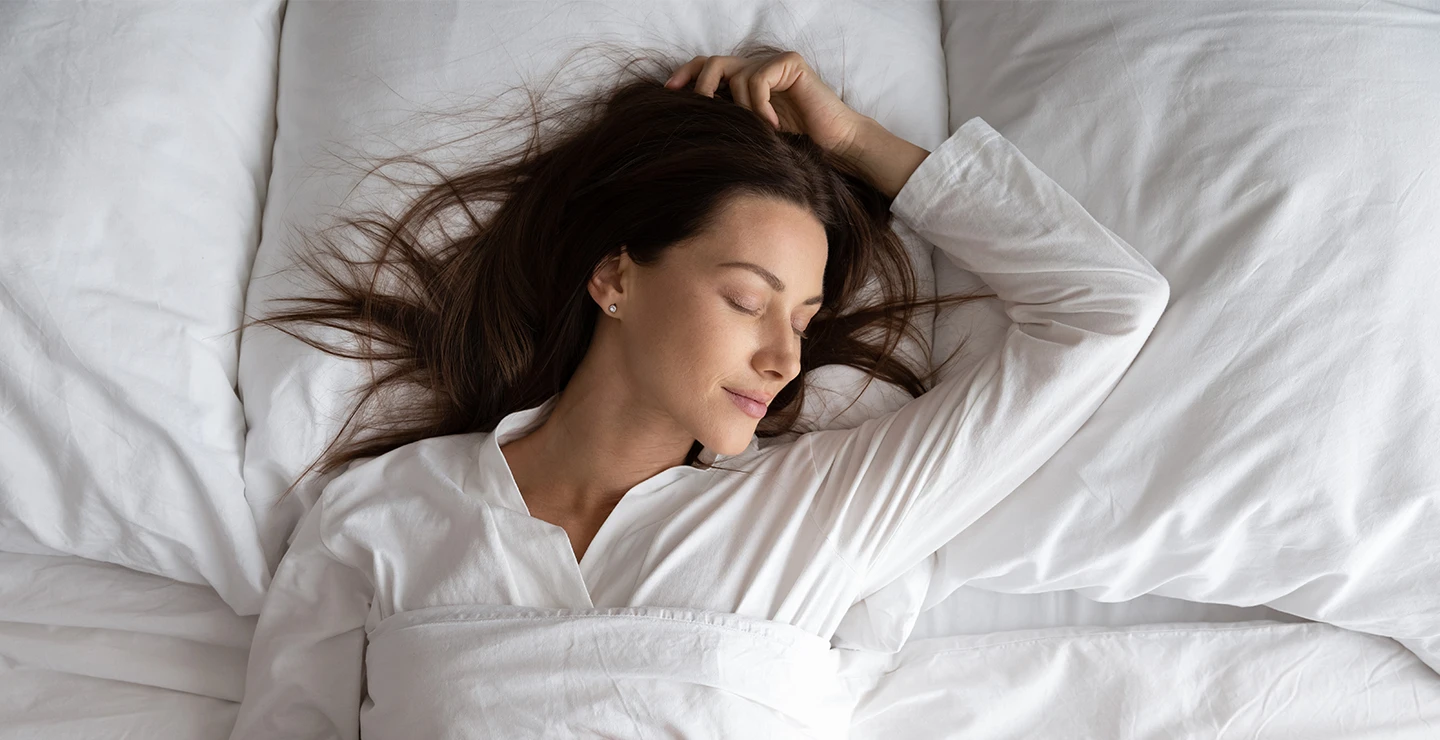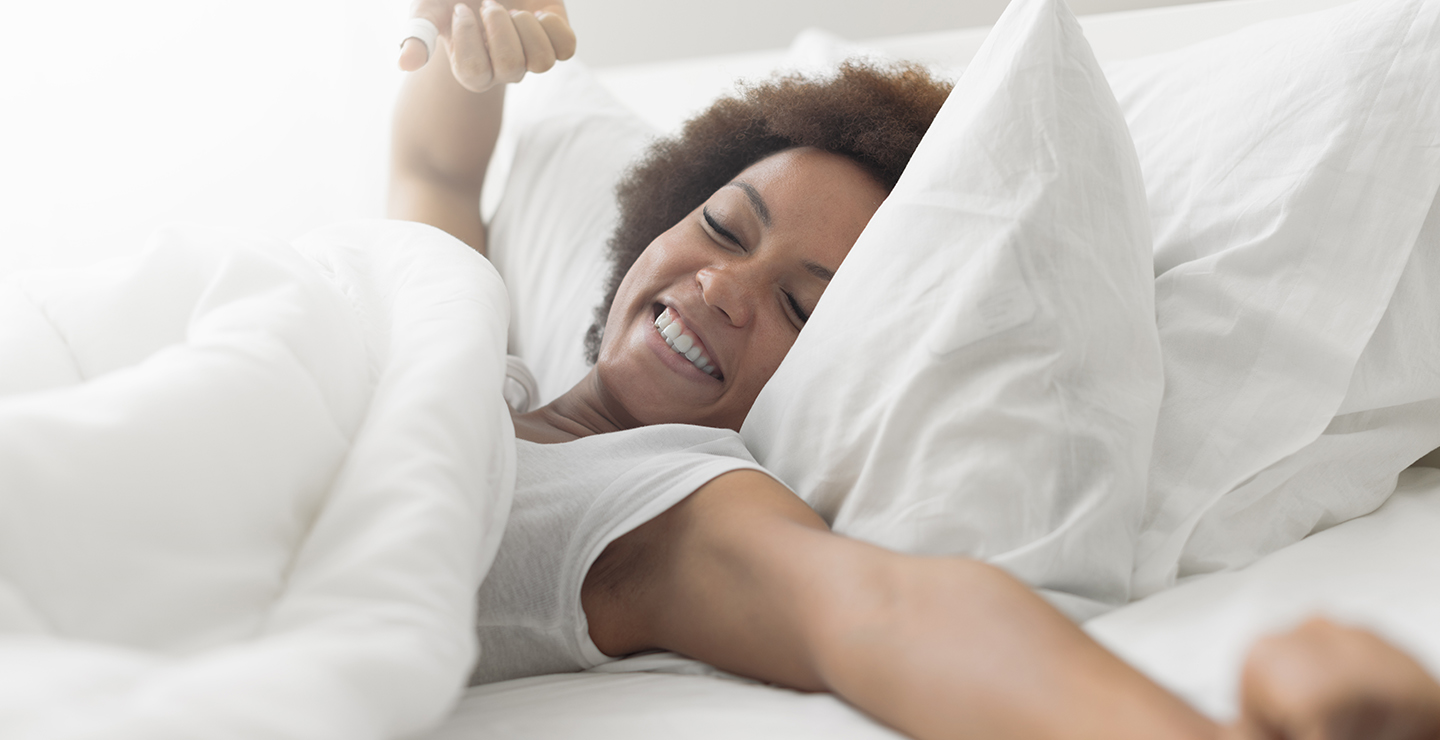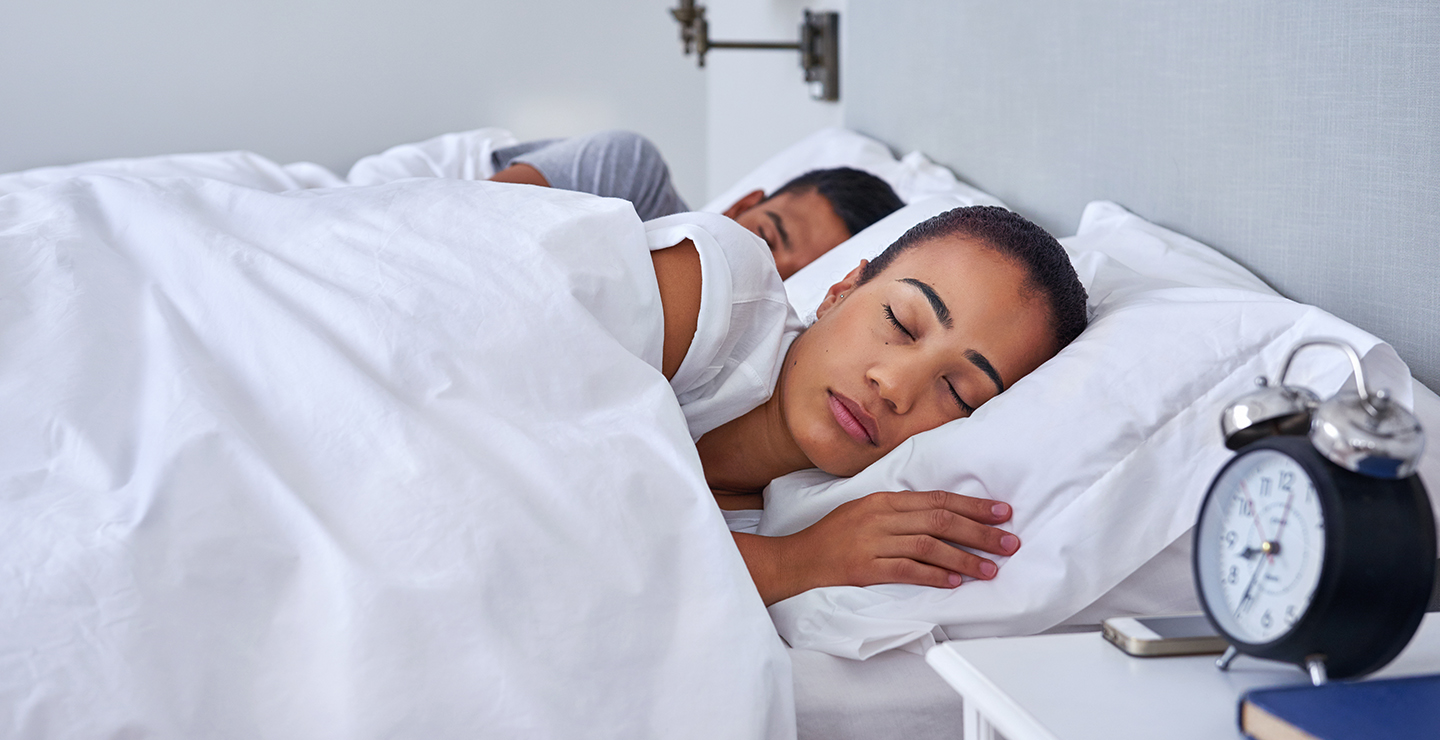9 Facts About REM Sleep and Why You Need It
Sweet dreams—or should we say, sweet REM sleep? REM sleep is the phase of sleep associated with quick, darting eye movements, vivid dreaming, memory formation, and emotion processing.
Struggles & Remedies


Sweet dreams—or should we say, sweet REM sleep? REM sleep is the phase of sleep associated with quick, darting eye movements, vivid dreaming, memory formation, and emotion processing. 1 During REM sleep, our brain activity, breathing, and heart rate resemble our waking state more than during other stages of sleep. 1
Every night, adults spend about 25 percent of their sleep in Rapid Eye Movement (REM) sleep. The remaining 75 percent of our time asleep is spent in NREM— non-rapid eye movement sleep. 1
REM sleep is important for processing emotions, as well as learning, memory storage, and information processing, some of which also occur during NREM sleep. 2 REM sleep may also help prepare you to wake up. 2
Every night, adults spend about 25 percent of their sleep in Rapid Eye Movement (REM) sleep. The remaining 75 percent of our time asleep is spent in NREM— non-rapid eye movement sleep. 1
REM sleep is important for processing emotions, as well as learning, memory storage, and information processing, some of which also occur during NREM sleep. 2 REM sleep may also help prepare you to wake up. 2
What is the Purpose of REM Sleep?
Every night, our brains cycle through periods of REM and NREM sleep. The first phase of REM sleep is about 90 minutes after you fall asleep. 2 The shortest REM phase, it lasts only about 10 minutes. 1 Each successive REM phase lasts longer, with the longest REM cycles occurring just before waking. 1-3
While the other 3 stages of sleep are associated with the healing, growth, and regeneration of our cells, tissues, and immune system, REM sleep is all about the brain and connections between nerve cells. Specifically, REM sleep:
While the other 3 stages of sleep are associated with the healing, growth, and regeneration of our cells, tissues, and immune system, REM sleep is all about the brain and connections between nerve cells. Specifically, REM sleep:
- Affects the processes that control how memory and learning work. 4
- Helps with memory consolidation—in other words, turn short-term memories into long-term memories. 5
As we go through the day, the experiences we attempt to commit to memory are temporarily stored. During stage 3 (also known as slow wave sleep) and REM sleep, that information is encoded and transferred to long-term memory storage.
What are the Stages of Sleep?
The stages of sleep include three stages of NREM sleep and one stage of REM sleep that repeat throughout the night in sequence.1, 3
Each of the three phases of NREM sleep is characterized by changes in muscle tone, changes in heart rate, and a decrease in body temperature. Each phase of sleep also shows distinct changes in your brainwaves.1, 6
Keep reading to learn more about each stage of sleep:1, 3
Each of the three phases of NREM sleep is characterized by changes in muscle tone, changes in heart rate, and a decrease in body temperature. Each phase of sleep also shows distinct changes in your brainwaves.1, 6
Keep reading to learn more about each stage of sleep:1, 3
Stage 1 Sleep
Stage 1 is the lightest stage of sleep and transitions us from wakefulness to sleep. It is essentially the “falling asleep” stage and is very brief, lasting 5 to 10 minutes. Your eye movements, breathing and heart rate slow. Your brainwaves begin to slow.
Stage 2 Sleep
In stage 2 sleep, you are lightly but fully asleep. Your eye moments slow and stop as your heart rate continues to drop. Your body temperature drops and your brainwave activity continues to slow, with brief bursts of activity. Stage 2 NREM sleep lasts up to 25 minutes.
Stage 3 Sleep
This is the deepest stage of sleep. In deep sleep, your heart rate and breathing have reached their lowest, slowest points. At this stage it’s hard to be woken up. Waking from this phase of sleep may leave you disorientated and confused. There are no eye movements.
During stage 3 sleep, your body regenerates cells and tissues and grows new cells. The immune system is also working hard. It’s this stage of sleep that allows you to feel physically well-rested in the morning.
During stage 3 sleep, your body regenerates cells and tissues and grows new cells. The immune system is also working hard. It’s this stage of sleep that allows you to feel physically well-rested in the morning.
Stage 4 Sleep—REM Sleep
REM sleep is the last sleep stage before the cycle repeats. In REM sleep, you dream more than in NREM sleep—and more vividly—and your brain activity increases dramatically. The parts of the brain that coordinate input from our senses, govern emotions, and create memories are active during REM sleep. Your breathing rate increases as does your blood pressure and heart rate. Each of your later REM stages gets longer the more hours you’re asleep.1,-2
Can you imagine what would happen if your body reacted to your wildest dreams? REM sleep takes care of that, immobilizing your skeletal muscles so that you don’t move while you dream. Most voluntary, skeletal muscles are paralyzed during REM sleep—muscles you need to live, of course, like the muscles that allow you to breathe and your heart to beat, remain active.
Can you imagine what would happen if your body reacted to your wildest dreams? REM sleep takes care of that, immobilizing your skeletal muscles so that you don’t move while you dream. Most voluntary, skeletal muscles are paralyzed during REM sleep—muscles you need to live, of course, like the muscles that allow you to breathe and your heart to beat, remain active.
How Much REM Sleep Do You Need?
Getting to the REM phase of sleep requires passing through the NREM stages of sleep first, so it takes a full night’s worth of sleep to get enough REM sleep. Adults need to spend about 20 to 25 percent of their sleep time in REM sleep, broken up into 3 to 5 phases. Overall, adults need 7 to 9 hours of sleep—about 90 minutes of which need to be REM sleep.7
Because REM sleep comes in cycles, it’s broken up over the span of a night’s sleep. Typically, the final REM stage of the night ends not long before we wake up.1,-2
Because of what happens during REM sleep – particularly in the brain – it’s so important to get enough REM sleep every night, so you can wake up refreshed and ready to go.
Because REM sleep comes in cycles, it’s broken up over the span of a night’s sleep. Typically, the final REM stage of the night ends not long before we wake up.1,-2
Because of what happens during REM sleep – particularly in the brain – it’s so important to get enough REM sleep every night, so you can wake up refreshed and ready to go.
What Happens If You Don’t Get Enough REM Sleep?
Not getting enough sleep, whether NREM or REM sleep, can and will definitely impact your overall well-being, beyond just feeling tired or sleepy during the day.
A lack of REM sleep is particularly associated with:
A lack of REM sleep is particularly associated with:
- An increased risk of weight gain.
Decreased levels of REM sleep seem to be associated with lower levels of leptin, a hormone that promotes feelings of fullness.8
- Impaired procedural learning and memory. Our ability to learn and retain what we learn, such as a foreign language or motor coordination patterns, relies on REM sleep, and becomes more difficult when we get less of it.9
What Happens If You Wake Up During REM Sleep?
Waking up during REM sleep can lead to sleep paralysis, a temporary condition in which a person returns to wakefulness yet cannot move because their voluntary muscles are still “shut off.” Although sleep paralysis is not dangerous it can be scary or uncomfortable.10 Sleep inertia is also common-- it is the feeling of grogginess, disorientation, drowsiness, and cognitive impairment that immediately follows waking.11,-12
9 Interesting Facts About REM Sleep
REM sleep was first discovered and scientifically described in 1953.2 Since then, sleep scientists have kept finding out more and more about this fascinating phase of our sleeping lives.
Here are some interesting facts about REM sleep you may not have known.
Here are some interesting facts about REM sleep you may not have known.
1. When our eyes move during REM sleep, they’re “looking” at our dreams.
The rapid eye movements in REM are caused by the brain’s complex array of nerve tissue devoted to sight and visual processes, treating dreams as if they were part of the “real” external environment. Each rapid eye movement is part of a visual scan, just like we do when we’re awake and focusing on an object or scene.13,-14
2. Your muscles are paralyzed during REM sleep.
As you cycle into REM sleep, your brain paralyzes your skeletal muscles by relaxing them. This form of paralysis, called atonia, is thought to be necessary to help keep you safe and prevent you from harming yourself by physically acting out your dreams. Consider what would happen if, in a dream, you were running a race and still able to move around.3
3. REM sleep is essential for creativity and problem-solving.
Studies have shown that even brief periods of REM sleep enable us to make stronger neurological associations between existing memories. This allows us to pull together many different pieces of information when we’re faced with a problem needing a creative solution.15 The synergy of NREM and REM sleep stages may support complex problem solving.15
4. REM sleep helps rejuvenate and refresh the brain.
It may seem paradoxical that REM sleep refreshes the brain. After all, during REM sleep the brain is highly active and performing complex tasks, like forming memories and restoring its supplies of neurotransmitters. All these processes are essential for us to feel mentally renewed every day.
5. You get less REM sleep as you age.
Newborns get the most REM of any age group, with 50 percent or more of their sleep taken up by REM stage sleep.3, 16 Adults spend up to 25 percent of their time asleep in REM sleep, and that percentage goes down as we age.3,16
6. Sleep deprivation and stress lead to REM rebound.
When we are sleep deprived, or experience stress, our bodies respond with a compensating mechanism to restore sleep balance and health benefits by passing through the other phases of sleep more rapidly to lengthen time in REM sleep.17, 18 This is referred to as “REM rebound,” and is temporary.
7. Although alcohol affects all phases of sleep, it particularly alters REM sleep architecture.
The brain is very active during REM sleep and consumption of alcohol, a central nervous system sedative, may delay the first onset of REM sleep19; it may also decrease REM early in the night.16 As the effects of alcohol wear off, REM rebound may potentially occur, increasing subsequent REM stages.16
8. REM sleep is important for children.
Young children learn new things every day, from new skills to new facts and information. REM sleep is critical in brain development and forming the associations that allow us to remember newly learned skills and recall facts. Babies spend up to four times as much sleep time in REM as do adults; by age 5, children will have similar sleep architecture (pattern of sleep stage cycles) as adults.2, 16
9. REM sleep is governed by the “oldest” parts of the brain.
The pons and medulla, both in the brainstem, are responsible for REM sleep.1 They’re often considered part of the reptilian cortex, an ancient part of the brain responsible for basic life-sustaining processes.20
How to Encourage Healthy Sleep Hygiene
Establishing healthy sleep habits is essential to your overall health. Promoting a healthy lifestyle goes hand-in-hand with ensuring that you are not only getting enough sleep, but also getting quality sleep.
ZzzQuil is here to help you on your journey to your best sleep. Sign up for ZzzQuil’s Better Sleep in 1-2-Zzz to learn more about how you can optimize your sleep routine.
ZzzQuil is here to help you on your journey to your best sleep. Sign up for ZzzQuil’s Better Sleep in 1-2-Zzz to learn more about how you can optimize your sleep routine.
References:
- Patel AK, Reddy V, Araujo JF. Physiology, Sleep Stages. In: StatPearls. Accessed August 11, 2022. Available at: https://www.ncbi.nlm.nih.gov/books/NBK526132/
- Sleep Foundation. What is REM sleep and how much do you need?. Accessed August 11, 2022. Available at: https://www.sleepfoundation.org/stages-of-sleep/rem-sleep
- U.S. Department of Health and Human Services. National Institutes of Health. National Institute of Neurological Disorders and Stroke (NINDS). Brain basics: Understanding sleep. Accessed August 11, 2022. Available at: https://www.ninds.nih.gov/health-information/patient-caregiver-education/brain-basics-understanding-sleep
- Sara S. Sleep to remember. Journal of Neuroscience.18 January 2017, 37 (3) 457-463. Accessed August 11, 2022. Available at: https://www.jneurosci.org/content/37/3/457
- Ackermann S, Rasch B. Differential effects of non-REM and REM sleep on memory consolidation. Current Neurology and Neuroscience Reports. Current Neurology and Neuroscience Reports 2014:14(2); 430. Accessed August 11, 2022. Available at: https://pubmed.ncbi.nlm.nih.gov/24395522/
- Delimaynati M, Purnama B, Nguyen N, Faisal M. Classification of brainwaves for sleep stages by high-dimensional FFT features from EEG signals. MDPI. Accessed August 11, 2022. Available at: from https://www.mdpi.com/2076-3417/10/5/1797/html
- Institute of Medicine (US) Committee on Sleep Medicine and Research; Colten HR, Altevogt BM, editors. Sleep Disorders and Sleep Deprivation: An Unmet Public Health Problem. Washington (DC): National Academies Press (US); 2006. 2, Sleep Physiology. Accessed August 11, 2022. Available from: https://www.ncbi.nlm.nih.gov/books/NBK19956/
- Olson CA, Hamilton NA, Somers VK. Percentage of REM sleep is associated with overnight change in leptin. J Sleep Res. 2016;25(4):419-425. Accessed August 11, 2022. Available at: https://doi.org/10.1111/jsr.12394
- Rasch B, Born J. About sleep's role in memory. Physiol Rev. 2013;93(2):681-766. Accessed August 11, 2022. Available at: https://doi.org/10.1152/physrev.00032.2012
- Sharpless BA. A clinician's guide to recurrent isolated sleep paralysis. Neuropsychiatr Dis Treat. 2016;12:1761-1767. Published 2016 Jul 19. doi:10.2147/NDT.S100307. Accessed August 11, 2022. Available at: https://www.ncbi.nlm.nih.gov/pmc/articles/PMC4958367/
- Trotti LM. Waking up is the hardest thing I do all day: Sleep inertia and sleep drunkenness. Sleep Med Rev. 2017;35:76-84. https://doi.org/10.1016/j.smrv.2016.08.005
- Sleep Foundation. Sleep Inertia. Accessed August 11, 2022. Available at: https://www.sleepfoundation.org/how-sleep-works/sleep-inertia
- Leclair-Visonneau L, Oudiette D, Gaymard B, Leu-Semenescu S, Arnulf I. Do the eyes scan dream images during rapid eye movement sleep? Evidence from the rapid eye movement sleep behaviour disorder model. [published correction appears in Brain. 2011 Jul;134(Pt 7):1286]. Brain. 2010;133(Pt 6):1737-1746. doi:10.1093/brain/awq110. Accessed August 11, 2022. Available at: https://pubmed.ncbi.nlm.nih.gov/20478849/
- Andrillon T, Nir Y, Cirelli C, Tononi G, Fried I. Single-neuron activity and eye movements during human REM sleep and awake vision. Nat Commun. 2015;6:7884. Accessed August 22, 2022. Available at https://doi.org/10.1038/ncomms8884
- Lewis PA, Knoblich G, Poe G. How Memory Replay in Sleep Boosts Creative Problem-Solving. Trends Cogn Sci. 2018;22(6):491-503. Accessed August 11, 2022. Available at: https://doi.org/10.1016/j.tics.2018.03.009
- Sleep Foundation. Stages of Sleep. Accessed August 11, 2022. Available at: https://www.sleepfoundation.org/stages-of-sleep
- Feriante J, Singh S. REM Rebound Effect. StatPearls Publishing. Accessed August 11, 2022. Available at: https://www.ncbi.nlm.nih.gov/books/NBK560713/
- Suchecki D, Tiba PA, Machado RB. REM Sleep Rebound as an Adaptive Response to Stressful Situations. Front Neurol.2012;3:41. Published 2012 Apr 2. doi:10.3389/fneur.2012.00041 Accessed August 11, 2022. Available at: https://www.ncbi.nlm.nih.gov/pmc/articles/PMC3317042/
- Feriante J, Araujo JF. Physiology, REM Sleep. StatPearls Publishing. Accessed August 11, 2022. Available at: https://www.ncbi.nlm.nih.gov/books/NBK531454/
- Naumann RK, Ondracek JM, Reiter S, et al. The reptilian brain. Curr Biol. 2015;25(8):R317-R321. doi:10.1016/j.cub.2015.02.049 Accessed August 11, 2022. Available at: https://pubmed.ncbi.nlm.nih.gov/25898097/




